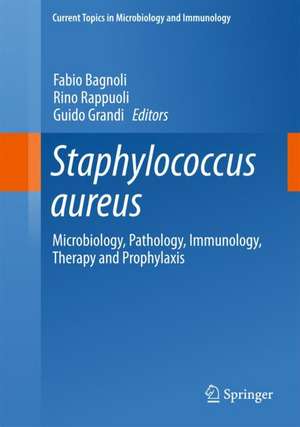Staphylococcus aureus: Microbiology, Pathology, Immunology, Therapy and Prophylaxis: Current Topics in Microbiology and Immunology, cartea 409
Editat de Fabio Bagnoli, Rino Rappuoli, Guido Grandien Limba Engleză Hardback – feb 2018
All chapters were written by respected experts in the field – presenting recent findings on a diverse range of aspects, they are nonetheless interlinked. As such, the book is a must-read for all researchers, clinicians and technicians engaged in basic or applied science work involving S. aureus.
| Toate formatele și edițiile | Preț | Express |
|---|---|---|
| Paperback (1) | 1108.35 lei 6-8 săpt. | |
| Springer International Publishing – 6 iun 2019 | 1108.35 lei 6-8 săpt. | |
| Hardback (1) | 1620.35 lei 6-8 săpt. | |
| Springer International Publishing – feb 2018 | 1620.35 lei 6-8 săpt. |
Din seria Current Topics in Microbiology and Immunology
- 18%
 Preț: 962.03 lei
Preț: 962.03 lei - 5%
 Preț: 1123.13 lei
Preț: 1123.13 lei - 5%
 Preț: 1085.95 lei
Preț: 1085.95 lei -
 Preț: 499.77 lei
Preț: 499.77 lei - 5%
 Preț: 967.81 lei
Preț: 967.81 lei - 18%
 Preț: 1118.62 lei
Preț: 1118.62 lei - 5%
 Preț: 717.00 lei
Preț: 717.00 lei - 5%
 Preț: 712.97 lei
Preț: 712.97 lei - 5%
 Preț: 709.51 lei
Preț: 709.51 lei - 5%
 Preț: 709.51 lei
Preț: 709.51 lei - 5%
 Preț: 721.19 lei
Preț: 721.19 lei - 5%
 Preț: 359.78 lei
Preț: 359.78 lei - 5%
 Preț: 711.88 lei
Preț: 711.88 lei - 5%
 Preț: 774.81 lei
Preț: 774.81 lei - 15%
 Preț: 640.06 lei
Preț: 640.06 lei - 5%
 Preț: 717.00 lei
Preț: 717.00 lei - 5%
 Preț: 360.34 lei
Preț: 360.34 lei - 5%
 Preț: 707.69 lei
Preț: 707.69 lei - 5%
 Preț: 717.56 lei
Preț: 717.56 lei - 5%
 Preț: 716.28 lei
Preț: 716.28 lei - 5%
 Preț: 717.20 lei
Preț: 717.20 lei - 5%
 Preț: 711.32 lei
Preț: 711.32 lei - 5%
 Preț: 711.88 lei
Preț: 711.88 lei - 5%
 Preț: 718.29 lei
Preț: 718.29 lei - 5%
 Preț: 709.51 lei
Preț: 709.51 lei - 5%
 Preț: 369.84 lei
Preț: 369.84 lei - 5%
 Preț: 712.25 lei
Preț: 712.25 lei - 5%
 Preț: 716.45 lei
Preț: 716.45 lei - 5%
 Preț: 706.60 lei
Preț: 706.60 lei - 5%
 Preț: 711.52 lei
Preț: 711.52 lei - 5%
 Preț: 713.54 lei
Preț: 713.54 lei - 5%
 Preț: 720.47 lei
Preț: 720.47 lei - 5%
 Preț: 725.42 lei
Preț: 725.42 lei - 5%
 Preț: 708.06 lei
Preț: 708.06 lei - 5%
 Preț: 713.70 lei
Preț: 713.70 lei - 5%
 Preț: 705.83 lei
Preț: 705.83 lei - 5%
 Preț: 710.96 lei
Preț: 710.96 lei - 5%
 Preț: 723.93 lei
Preț: 723.93 lei - 5%
 Preț: 707.69 lei
Preț: 707.69 lei - 5%
 Preț: 715.35 lei
Preț: 715.35 lei - 5%
 Preț: 709.87 lei
Preț: 709.87 lei - 5%
 Preț: 359.05 lei
Preț: 359.05 lei - 5%
 Preț: 374.20 lei
Preț: 374.20 lei - 15%
 Preț: 635.31 lei
Preț: 635.31 lei - 5%
 Preț: 707.86 lei
Preț: 707.86 lei - 5%
 Preț: 721.96 lei
Preț: 721.96 lei - 15%
 Preț: 632.88 lei
Preț: 632.88 lei - 15%
 Preț: 632.05 lei
Preț: 632.05 lei - 15%
 Preț: 642.83 lei
Preț: 642.83 lei
Preț: 1620.35 lei
Preț vechi: 1705.63 lei
-5% Nou
Puncte Express: 2431
Preț estimativ în valută:
310.10€ • 322.55$ • 255.100£
310.10€ • 322.55$ • 255.100£
Carte tipărită la comandă
Livrare economică 14-28 aprilie
Preluare comenzi: 021 569.72.76
Specificații
ISBN-13: 9783319720616
ISBN-10: 3319720619
Pagini: 530
Ilustrații: XII, 540 p.
Dimensiuni: 155 x 235 mm
Greutate: 0.95 kg
Ediția:1st ed. 2017
Editura: Springer International Publishing
Colecția Springer
Seria Current Topics in Microbiology and Immunology
Locul publicării:Cham, Switzerland
ISBN-10: 3319720619
Pagini: 530
Ilustrații: XII, 540 p.
Dimensiuni: 155 x 235 mm
Greutate: 0.95 kg
Ediția:1st ed. 2017
Editura: Springer International Publishing
Colecția Springer
Seria Current Topics in Microbiology and Immunology
Locul publicării:Cham, Switzerland
Cuprins
Clinical microbiology, transmission and carriage of Staphylococcus aureus.- Worldwide Epidemiology and antibiotic resistance of Staphylococcus aureus.- Structure and function of surface polysaccharides of Staphylococcus aureus.- Structure and function of surface proteins of Staphylococcus aureus.- Staphylococcus aureus pore-forming toxins.-Regulation of Staphylococcus aureus genes.- Staphylococcus aureus-associated Skin and Soft Tissue Infections.- Staphylococcus aureus-associated Musculoskeletal Infections.- Bacteremia, Sepsis, and Infective Endocarditis associated to Staphylococcus aureus.- Staphylococcus aureus as a zoonotic pathogen.- Antibiotic therapy of Staphylococcus aureus.- Innate immune responses against Staphylococcus aureus.- Adaptive immune responses against Staphylococcus aureus.- Immunevasion mechanisms of Staphylococcus aureus.- Vaccines and target populations for Staphylococcus aureus.- Bacteriophage and lysine therapy of Staphylococcus aureus.
Notă biografică
Fabio Bagnoli
Rino Rappuoli
GSK Vaccines, Siena, Italy
e-mail: fabio.x.bagnoli@gsk.com
Rino Rappuoli
GSK Vaccines, Siena, Italy
e-mail: rino.r.rappuoli@gsk.com
Guido Grandi
University of Trento, Povo, Italye-mail: guido.grandi@unitn.it
Textul de pe ultima copertă
This volume offers a comprehensive overview of basic and applied aspects of Staphylococcus aureus, which is one of the most important human pathogens. It includes sixteen chapters that address the microbiology and immunology of S. aureus, the pathology of its key manifestations, and the current standard of care. Further, it reviews cutting-edge advances in alternative therapeutic and prophylactic approaches to antibiotics.
All chapters were written by respected experts in the field – presenting recent findings on a diverse range of aspects, they are nonetheless interlinked. As such, the book is a must-read for all researchers, clinicians and technicians engaged in basic or applied science work involving S. aureus.
Caracteristici
Summarizes cutting-edge findings on virulence factors, mechanisms of protection and therapeutic approaches Equips readers with a fundamental tool for working on Staphylococcus aureus Offers an invaluable source of information for a broad audience ranging from clinicians to academic researchers and applied scientists
